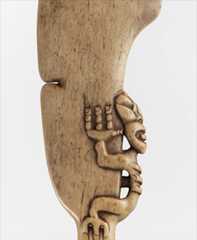Story: Mau rākau – Māori use of weaponry

The use of traditional Māori weaponry declined after Europeans arrived in New Zealand. Weapons such as taiaha (fighting staffs) were replaced by muskets, and para whakawai (weaponry training schools) vanished. Since the 1980s, as part of the Māori cultural renaissance, there has been renewed interest in traditional weapons – although a narrower range than were once in use.
Story by Rangi Matamua
Main image: Wahaika parāoa (whalebone club)
Story summary
Weapons training
Warfare and weaponry were an important part of traditional Māori society. Children were prepared for warfare from an early age, including through play activities such as boxing, wrestling and stick-throwing games.
In the para whakawai (weapons training school) young men learnt mau rākau (the use of weapons). They were instructed in battle formations, weapon use, and attack and defence moves, and took part in mock battles using reeds instead of weapons. Rakanga waewae (skilful footwork) was important.
Weapons
To Māori, weapons were taonga (treasures), and were often handed down to descendants. Weapons were made of wood, stone and bone, in a slow, painstaking process.Karakia (incantations) were sometimes said over weapons to imbue them with deities and make themtapu (sacred).
Long two-handed weapons had a long, flat blade for striking and a sharp pointed end. They included:
- taiaha, elaborately carved and decorated fighting staffs that were prized treasures
- tewhatewha, which were shaped like axes, and decorated with feathers used to distract the enemy
- spear-like weapons such as pouwhenua, koikoi and tararua.
Short one-handed weapons were called patu. They were held in one hand and a mat was wrapped around the other arm as a shield.
Decline
After Europeans arrived in New Zealand, the use of Māori weapons declined. Taiaha were quickly replaced by muskets (firearms). Over the years para whakawai stopped operating and many tribes lost their knowledge of weapons.
Revival
Since the 1980s there has been a revival of traditional weapons as part of the Māori cultural renaissance. A small number of para whakawai have been set up, mostly within a tribal framework. Weapons are used during thewero ceremony (ritual challenge to visitors), inkapa haka performances andwhaikōrero (speechmaking).
How to cite this page
Rangi Matamua, Mau rākau – Māori use of weaponry, Te Ara – the Encyclopedia of New Zealand, https://teara.govt.nz/en/mau-rakau-maori-use-of-weaponry (accessed 27 October 2025).
Story by Rangi Matamua, published 20 December 2016.


